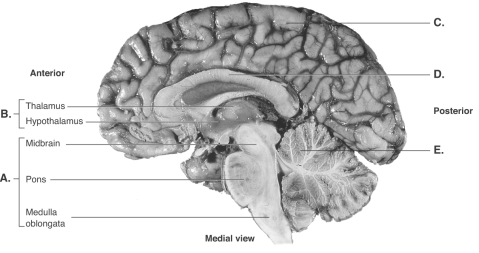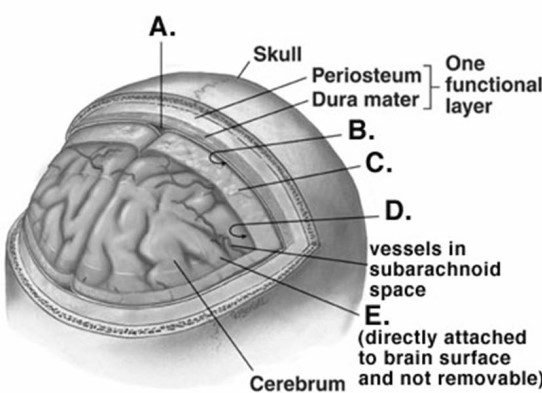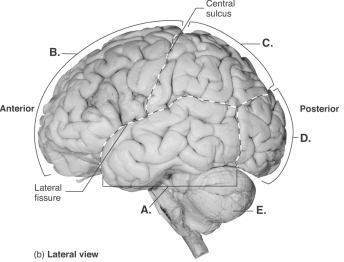A) facial
B) glossopharyngeal
C) accessory
D) optic
E) oculomotor
G) A) and E)
Correct Answer

verified
Correct Answer
verified
Multiple Choice
 -This is a midsagittal section of the right half of the brain.What does "B" represent?
-This is a midsagittal section of the right half of the brain.What does "B" represent?
A) cerebrum
B) cerebellum
C) corpus callosum
D) diencephalon
E) brainstem
G) B) and D)
Correct Answer

verified
Correct Answer
verified
Multiple Choice
Facial expression is regulated by the
A) facial nerve.
B) vagus nerve.
C) abducens nerve.
D) trigeminal nerve.
E) accessory nerve.
G) B) and D)
Correct Answer

verified
Correct Answer
verified
Multiple Choice
Cerebrospinal fluid is formed by tissue in the walls and roofs of the
A) subarachnoid space.
B) dural sinuses.
C) fissure of Sylvius.
D) ventricles of the brain.
E) subdural space.
G) B) and D)
Correct Answer

verified
Correct Answer
verified
Multiple Choice
 -What does "D" represent on the diagram of the skull and brain?
-What does "D" represent on the diagram of the skull and brain?
A) subarachnoid space
B) dural venous sinus
C) pia mater
D) arachnoid mater
E) subdural space
G) A) and C)
Correct Answer

verified
Correct Answer
verified
Multiple Choice
 -This is a midsagittal section of the right half of the brain.What does "A" represent?
-This is a midsagittal section of the right half of the brain.What does "A" represent?
A) cerebrum
B) cerebellum
C) corpus callosum
D) diencephalon
E) brainstem
G) A) and D)
Correct Answer

verified
Correct Answer
verified
Multiple Choice
Afferent fibers terminating in the hypothalamus provide input from the
A) visceral organs.
B) taste receptors of the tongue.
C) limbic system.
D) the prefrontal cortex of the cerebrum.
E) All of these choices are correct.
G) None of the above
Correct Answer

verified
Correct Answer
verified
Multiple Choice
Walking a tightrope would activate what portion(s) of the medulla?
A) the pyramids
B) the superior colliculi
C) the olives
D) the pyramids and the superior colliculi
E) the pyramids and the olives
G) B) and D)
Correct Answer

verified
Correct Answer
verified
Multiple Choice
When you walk up behind someone and tap their right shoulder,they will reflexively
A) raise their arms.
B) hit you.
C) turn their head toward the left.
D) sneeze.
E) turn their head toward the right.
G) None of the above
Correct Answer

verified
Correct Answer
verified
Multiple Choice
 -This is a lateral view of the brain.What does "B" represent?
-This is a lateral view of the brain.What does "B" represent?
A) temporal lobe
B) cerebellum
C) frontal lobe
D) occipital lobe
E) parietal lobe
G) All of the above
Correct Answer

verified
Correct Answer
verified
Multiple Choice
Arrange the following in order from the diencephalon downward. (1) spinal cord (2) midbrain (3) medulla (4) pons
A) 1,2,3,4
B) 2,4,3,1
C) 3,2,4,1
D) 4,2,3,1
E) 4,1,3,2
G) None of the above
Correct Answer

verified
Correct Answer
verified
Multiple Choice
A lesion in the cerebral peduncles might affect
A) hearing.
B) movement.
C) sight.
D) heart rate.
E) taste.
G) B) and E)
Correct Answer

verified
Correct Answer
verified
Multiple Choice
 -What does "A" represent on the diagram of the skull and brain?
-What does "A" represent on the diagram of the skull and brain?
A) subarachnoid space
B) dural venous sinus
C) pia mater
D) arachnoid mater
E) subdural space
G) A) and C)
Correct Answer

verified
Correct Answer
verified
Multiple Choice
From which germ layer does the nervous system form?
A) endoderm
B) mesoderm
C) exoderm
D) ectoderm
F) A) and C)
Correct Answer

verified
Correct Answer
verified
Multiple Choice
The glossopharyngeal nerve
A) innervates the larynx.
B) is involved in the sense of taste.
C) innervates intrinsic tongue muscles.
D) transmits sensory information from the abdominal viscera.
E) controls facial expressions.
G) A) and B)
Correct Answer

verified
Correct Answer
verified
Multiple Choice
The cerebral gyri increase
A) memory assimilation time.
B) the surface area of the cortex.
C) the size of the thalamic nuclei.
D) speech ability.
E) volume of the brain.
G) A) and C)
Correct Answer

verified
Correct Answer
verified
Multiple Choice
Which of the following cranial nerves innervates only one muscle of the eyeball?
A) optic nerve
B) facial nerve
C) trochlear nerve
D) trigeminal nerve
E) oculomotor nerve
G) B) and D)
Correct Answer

verified
Correct Answer
verified
Multiple Choice
Most sensory input that ascends through the spinal cord and brainstem projects to the
A) pineal gland.
B) hypothalamus.
C) thalamus.
D) mammillary bodies.
E) subthalamus.
G) None of the above
Correct Answer

verified
Correct Answer
verified
Multiple Choice
Tracts of white matter that connect the right and left hemispheres are composed of
A) decussation fibers.
B) association fibers.
C) commissural fibers.
D) projection fibers.
E) pyramidal fibers.
G) A) and C)
Correct Answer

verified
Correct Answer
verified
Multiple Choice
The substantia nigra interconnects with the
A) basal nuclei.
B) tegmentum.
C) red nuclei.
D) reticular nuclei.
E) tectum.
G) D) and E)
Correct Answer

verified
Correct Answer
verified
Showing 101 - 120 of 146
Related Exams